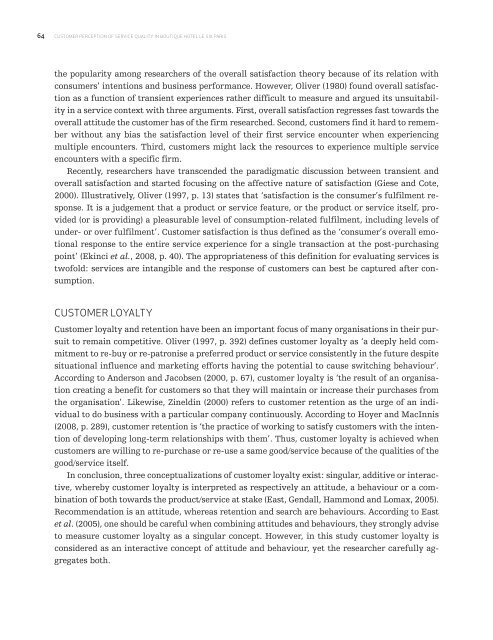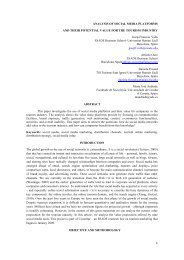customer perception of service quality in boutique hotel le six paris
customer perception of service quality in boutique hotel le six paris
customer perception of service quality in boutique hotel le six paris
Create successful ePaper yourself
Turn your PDF publications into a flip-book with our unique Google optimized e-Paper software.
64 CUSTOMER PERCEPTION OF SERVICE QUALITY IN BOUTIQUE HOTEL LE SIX PARIS<br />
the popularity among researchers <strong>of</strong> the overall satisfaction theory because <strong>of</strong> its relation with<br />
consumers’ <strong>in</strong>tentions and bus<strong>in</strong>ess performance. However, Oliver (1980) found overall satisfaction<br />
as a function <strong>of</strong> transient experiences rather difficult to measure and argued its unsuitability<br />
<strong>in</strong> a <strong>service</strong> context with three arguments. First, overall satisfaction regresses fast towards the<br />
overall attitude the <strong>customer</strong> has <strong>of</strong> the firm researched. Second, <strong>customer</strong>s f<strong>in</strong>d it hard to remember<br />
without any bias the satisfaction <strong>le</strong>vel <strong>of</strong> their first <strong>service</strong> encounter when experienc<strong>in</strong>g<br />
multip<strong>le</strong> encounters. Third, <strong>customer</strong>s might lack the resources to experience multip<strong>le</strong> <strong>service</strong><br />
encounters with a specific firm.<br />
Recently, researchers have transcended the paradigmatic discussion between transient and<br />
overall satisfaction and started focus<strong>in</strong>g on the affective nature <strong>of</strong> satisfaction (Giese and Cote,<br />
2000). Illustratively, Oliver (1997, p. 13) states that ‘satisfaction is the consumer’s fulfilment response.<br />
It is a judgement that a product or <strong>service</strong> feature, or the product or <strong>service</strong> itself, provided<br />
(or is provid<strong>in</strong>g) a p<strong>le</strong>asurab<strong>le</strong> <strong>le</strong>vel <strong>of</strong> consumption-related fulfilment, <strong>in</strong>clud<strong>in</strong>g <strong>le</strong>vels <strong>of</strong><br />
under- or over fulfilment’. Customer satisfaction is thus def<strong>in</strong>ed as the ‘consumer’s overall emotional<br />
response to the entire <strong>service</strong> experience for a s<strong>in</strong>g<strong>le</strong> transaction at the post-purchas<strong>in</strong>g<br />
po<strong>in</strong>t’ (Ek<strong>in</strong>ci et al., 2008, p. 40). The appropriateness <strong>of</strong> this def<strong>in</strong>ition for evaluat<strong>in</strong>g <strong>service</strong>s is<br />
tw<strong>of</strong>old: <strong>service</strong>s are <strong>in</strong>tangib<strong>le</strong> and the response <strong>of</strong> <strong>customer</strong>s can best be captured after consumption.<br />
CUSTOMER LOYALTY<br />
Customer loyalty and retention have been an important focus <strong>of</strong> many organisations <strong>in</strong> their pursuit<br />
to rema<strong>in</strong> competitive. Oliver (1997, p. 392) def<strong>in</strong>es <strong>customer</strong> loyalty as ‘a deeply held commitment<br />
to re-buy or re-patronise a preferred product or <strong>service</strong> consistently <strong>in</strong> the future despite<br />
situational <strong>in</strong>fluence and market<strong>in</strong>g efforts hav<strong>in</strong>g the potential to cause switch<strong>in</strong>g behaviour’.<br />
Accord<strong>in</strong>g to Anderson and Jacobsen (2000, p. 67), <strong>customer</strong> loyalty is ‘the result <strong>of</strong> an organisation<br />
creat<strong>in</strong>g a benefit for <strong>customer</strong>s so that they will ma<strong>in</strong>ta<strong>in</strong> or <strong>in</strong>crease their purchases from<br />
the organisation’. Likewise, Z<strong>in</strong>eld<strong>in</strong> (2000) refers to <strong>customer</strong> retention as the urge <strong>of</strong> an <strong>in</strong>dividual<br />
to do bus<strong>in</strong>ess with a particular company cont<strong>in</strong>uously. Accord<strong>in</strong>g to Hoyer and MacInnis<br />
(2008, p. 289), <strong>customer</strong> retention is ‘the practice <strong>of</strong> work<strong>in</strong>g to satisfy <strong>customer</strong>s with the <strong>in</strong>tention<br />
<strong>of</strong> develop<strong>in</strong>g long-term relationships with them’. Thus, <strong>customer</strong> loyalty is achieved when<br />
<strong>customer</strong>s are will<strong>in</strong>g to re-purchase or re-use a same good/<strong>service</strong> because <strong>of</strong> the qualities <strong>of</strong> the<br />
good/<strong>service</strong> itself.<br />
In conclusion, three conceptualizations <strong>of</strong> <strong>customer</strong> loyalty exist: s<strong>in</strong>gular, additive or <strong>in</strong>teractive,<br />
whereby <strong>customer</strong> loyalty is <strong>in</strong>terpreted as respectively an attitude, a behaviour or a comb<strong>in</strong>ation<br />
<strong>of</strong> both towards the product/<strong>service</strong> at stake (East, Gendall, Hammond and Lomax, 2005).<br />
Recommendation is an attitude, whereas retention and search are behaviours. Accord<strong>in</strong>g to East<br />
et al. (2005), one should be careful when comb<strong>in</strong><strong>in</strong>g attitudes and behaviours, they strongly advise<br />
to measure <strong>customer</strong> loyalty as a s<strong>in</strong>gular concept. However, <strong>in</strong> this study <strong>customer</strong> loyalty is<br />
considered as an <strong>in</strong>teractive concept <strong>of</strong> attitude and behaviour, yet the researcher carefully aggregates<br />
both.
















